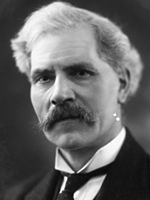National Government (1931–1935) facts for kids
Quick facts for kids National Government |
|
|---|---|
2nd National Government of the United Kingdom |
|
| 1931–1935 | |

Ramsey MacDonald
|
|
| Date formed | 27 October 1931 |
| Date dissolved | 7 June 1935 |
| People and organisations | |
| Monarch | George V |
| Prime Minister | Ramsay MacDonald |
| Prime Minister's history | 1929–1935 |
| Deputy Prime Minister | Stanley Baldwin |
| Total no. of members | 107 appointments |
| Member parties |
|
| Status in legislature | Supermajority (coalition)
554 / 615 (90%)
|
| Opposition party | Labour Party |
| Opposition leaders |
|
| History | |
| Election(s) | 1931 general election |
| Legislature term(s) | 36th UK Parliament |
| Predecessor | First National Government |
| Successor | Third National Government |
The National Government of 1931–1935 was a special type of government in the United Kingdom. It was formed by Ramsay MacDonald after he was asked by King George V to be Prime Minister of the United Kingdom again. This happened right after the general election in October 1931.
This government was called a National Government because it included members from several different political parties. These parties were the Conservative Party, the Liberals, the Liberal Nationals, and National Labour. There were also some people in the government who didn't belong to any political party.
The Liberal Nationals had not been part of MacDonald's earlier government. Their connection with the main Liberal Party was not very clear at first. But after the election, the Liberal Nationals officially separated from the main Liberal Party.
Contents
Key Events and Changes
During this government's time in power, some important changes happened. The ministers from the Liberal Party, led by Sir Herbert Samuel, decided to leave the government. This happened because the government started a new policy called "protectionism." This policy meant putting taxes on goods coming into the country. This was agreed upon during the Ottawa Accords in 1932.
The other Liberal group in the government, the Liberal National Party, had already agreed with the Conservative Party's idea of protectionism before the government was formed. So, their ministers stayed in their jobs.
In June 1935, Ramsay MacDonald decided to step down as Prime Minister. Stanley Baldwin then took over his role.
Who Was in the Cabinet?

The Cabinet is a group of the most important ministers in the government. They help the Prime Minister make big decisions. Here are some of the key people who were part of the Cabinet between November 1931 and May 1935:
- Ramsay MacDonald – He was the Prime Minister and the leader of the House of Commons.
- The Lord Sankey – He was the Lord Chancellor, a very important legal role.
- Stanley Baldwin – He was the Lord President, a senior minister.
- The Viscount Snowden – He held the role of Lord Privy Seal.
- Neville Chamberlain – He was the Chancellor of the Exchequer, in charge of the country's money.
- Sir Herbert Samuel – He was the Home Secretary, responsible for internal affairs.
- Sir John Simon – He was the Foreign Secretary, dealing with other countries.
- Sir Philip Cunliffe-Lister – He was the Colonial Secretary, looking after the colonies.
- J. H. Thomas – He was the Dominions Secretary, dealing with self-governing parts of the British Empire.
- The Viscount Hailsham – He was the Secretary of State for War and the leader in the House of Lords.
- Sir Samuel Hoare – He was the Secretary of State for India.
- The Marquess of Londonderry – He was the Secretary for Air.
- Sir Archibald Sinclair – He was the Secretary of State for Scotland.
- Sir Bolton Eyres-Monsell – He was the First Lord of the Admiralty, in charge of the navy.
- Walter Runciman – He was the President of the Board of Trade.
- Sir John Gilmour – He was the Minister of Agriculture.
- Sir Donald Maclean – He was the President of the Board of Education.
- Henry Betterton – He was the Minister of Labour.
- Hilton Young – He was the Minister of Health.
- William Ormsby-Gore – He was the First Commissioner of Works.
Cabinet Changes Over Time
The people in the Cabinet changed a few times:
- June 1932: Lord Irwin took over from Donald Maclean as President of the Board of Education after Maclean passed away.
- September 1932: Stanley Baldwin became Lord Privy Seal, while also remaining Lord President. John Gilmour became Home Secretary, replacing Herbert Samuel. Sir Godfrey Collins became Scottish Secretary, replacing Sir Archibald Sinclair. Walter Elliot became Minister of Agriculture, replacing Gilmour.
- December 1933: Stanley Baldwin stopped being Lord Privy Seal. Kingsley Wood joined the Cabinet as Postmaster-General.
- June 1934: Oliver Stanley took over from Henry Betterton as Minister of Labour.
Understanding the Parties
- = Member of National Labour
- = Member of the Conservative Party
- = Member of the Liberal Party
- = Member of the Liberal National Party
Images for kids


